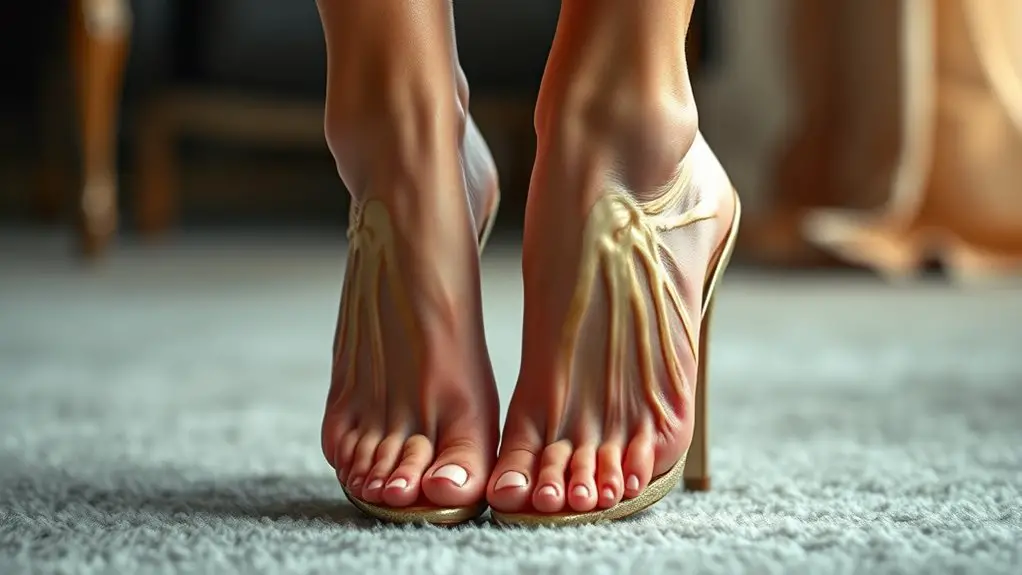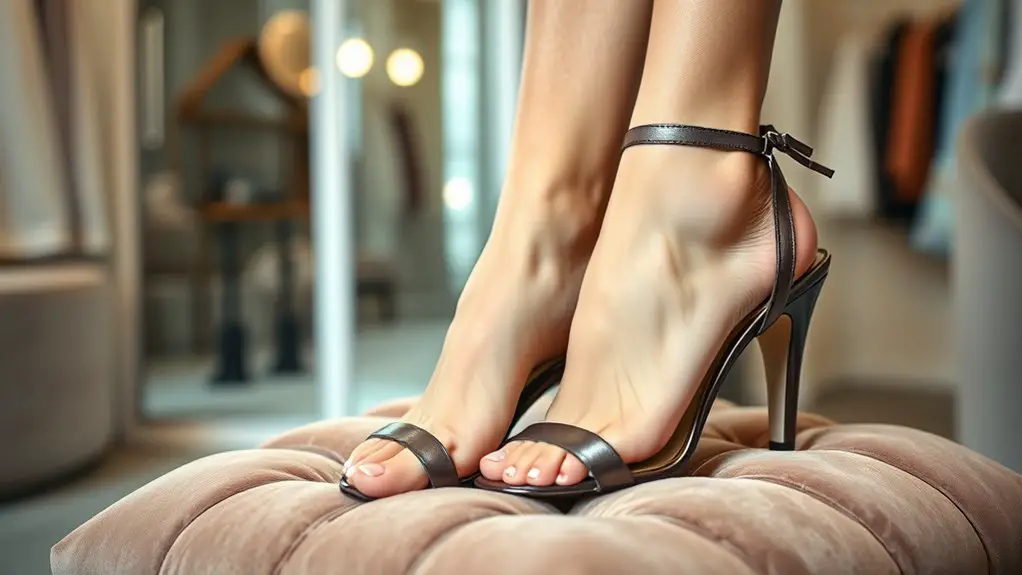Yes, you can train your feet to tolerate high heels. Start by gradually adapting to moderate heel heights, investing in shoes with arch support, and incorporating supportive insoles. Strengthening exercises, like toe curls and calf raises, boost resilience. Choose heels that distribute weight evenly to reduce forefoot pressure. Prioritize comfort by breaking in new heels at home. Following these techniques can greatly enhance your ability to wear high heels comfortably. Explore more strategies to guarantee a comfortable fit and style.
Understanding the Anatomy of Your Feet

Understanding the anatomy of your feet is essential for mastering high heel wear. Your foot structure consists of 26 bones, numerous ligaments, and muscles that work together to support your body weight and facilitate movement. High heels alter this natural alignment, shifting your weight forward and putting undue stress on the forefoot and toes. This can lead to discomfort and pain if your feet aren’t properly conditioned.
Familiarizing yourself with key areas such as the arch, metatarsals, and heel can aid in identifying pain points and developing strategies for pain relief. For instance, maintaining a strong arch may help distribute pressure more evenly across your foot. Additionally, knowing how your foot structure interacts with high heel design can guide you in choosing styles that minimize discomfort. Understanding these anatomical features allows you to make informed decisions that can enhance your high heel experience while reducing the risk of foot-related issues.
Gradual Adaptation Techniques
Since adapting to high heels can be challenging, employing gradual adaptation techniques is essential for minimizing discomfort and preventing injury. Start by selecting heels with a moderate heel height, ideally around 1-2 inches, to ease your feet into the change. Gradually increase the heel height over several weeks, allowing your feet to adjust incrementally.
Incorporate shoes that provide adequate arch support, as this can greatly enhance comfort and stability. Wearing supportive insoles can also help, especially in the initial stages of adaptation.
Set a schedule to wear your heels, beginning with short durations and slowly extending the time as your feet become accustomed. Pay attention to how your feet feel, and take breaks as needed. This gradual approach can help condition your feet, reducing the risk of pain or injury while improving your overall tolerance for high heels.
Strengthening Exercises for Foot Resilience

To enhance your feet’s resilience for high heel wear, incorporating specific strengthening exercises is essential. Focus on improving foot flexibility and toe strength to mitigate discomfort and prevent injury.
Begin with toe curls: while seated, curl your toes to grip a small towel, then release. Repeat this for 10-15 repetitions. Another effective exercise is the calf raise, which strengthens your arches and calves; stand on the edge of a step and slowly raise and lower your heels. Aim for 10-15 reps.
Additionally, practice ankle circles to improve mobility and flexibility. While seated, lift one foot and rotate your ankle in circles for about 30 seconds, then switch sides.
Finally, incorporate resistance bands to enhance toe strength; place a band around your toes and spread them apart, holding for a few seconds. Regularly performing these exercises can greatly boost your foot resilience, making high heel wear more tolerable.
Choosing the Right Heels
After strengthening your feet, the next step is selecting the right high heels to maximize comfort and minimize strain. Consider heel types and heel height when making your choice. Opt for lower heels or wedges, which distribute weight more evenly and reduce pressure on the forefoot.
Here’s a quick comparison table to guide your selection:
| Heel Type | Height Range | Comfort Level |
|---|---|---|
| Kitten Heels | 1-2 inches | High |
| Block Heels | 2-3 inches | Moderate |
| Stiletto | 3-4 inches | Low |
| Platform Heels | 2-4 inches | Moderate to High |
Choosing the right heel type and height can greatly impact your comfort level. Prioritize features like cushioning and arch support to further enhance your experience while wearing high heels.
Expert Tips for Comfort and Style

While you may prioritize style when choosing high heels, comfort should never be an afterthought. Proper attention to details can enhance both your experience and appearance. Here are some expert tips to keep in mind:
- Select the Right Heel Height: Aim for a heel height that suits your foot arch. Lower heels (1-2 inches) provide more stability, while higher heels (3 inches and above) shift weight forward.
- Choose Supportive Styles: Opt for shoes with arch support. This can reduce strain on your feet and help maintain proper alignment.
- Break Them In: Gradually wear your new heels at home to allow your feet to adapt. Start with short periods and gradually increase wear time.
- Use Cushioned Inserts: Consider gel inserts or cushioned pads to alleviate pressure points and enhance comfort throughout the day.
Frequently Asked Questions
Can High Heels Cause Long-Term Foot Damage?
Indeed, high heels can lead to long-term effects on foot health. You might experience issues like bunions or plantar fasciitis. Regular use could exacerbate these conditions, so it’s wise to prioritize your foot health.
What Heel Height Is Considered Safe for Beginners?
For beginners, a safe height for heels is typically around 1 to 2 inches. This range helps minimize discomfort and reduces the risk of injury, allowing your feet to gradually adapt to wearing elevated footwear.
Are There Specific Brands Known for Comfortable High Heels?
When choosing high heels, consider brands known for their comfortable designs and innovative heel technology. Brands like Cole Haan, Clarks, and Naturalizer prioritize comfort, providing supportive cushioning and stability to enhance your wearing experience.
How Often Should I Wear Heels to Build Tolerance?
To build tolerance, start with low heel wearing frequency, gradually increasing height. Aim for short durations a few times weekly, adjusting based on comfort. This method helps your feet adapt without excessive strain or injury.
Can Foot Arch Types Affect High Heel Comfort?
Yes, your foot arch types can markedly affect high heel comfort. Proper arch support and increased foot flexibility are essential for minimizing discomfort and enhancing stability while wearing heels, ultimately improving your overall experience.



